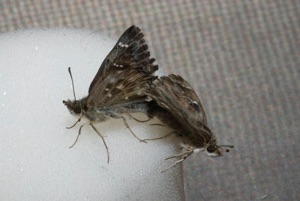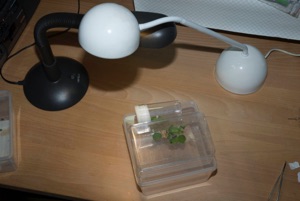Breeding Carcharodus Butterflies

Copulation
As with many butterflies this is the motst difficult part of breeding since due to a lack of free moving space the natural courtship behaviour (which is a precondition for the copulation) is being constrained. The copulation has been achieved by hand-pairing (for details compare Friedrich 1986, Breeding Butterflies and Moths) with C. alceae and C. lavatherae. Other attempts failed however, and even after successful copulations some or even all eggs that were obtained were sterile.
Flight cages were used in summer 2009 but without success.
Oviposition
So far successfully carried out with C. alceae, C. lavatherae, C. floccifera, C. orientalis and C. stauderi, partly under artificial light. If the females are fed regularly they can live for several weeks. For oviposition several methods can be used, e.g. with cages on watered plants or oviposition in small plastic tubes (see photograph) which is a more work-intensive method. Oviposition with bred females is difficult to reach or even fails. In some cases the eggs were partly or even completely sterile.
Breeding of first instars
Most easily on potted plants. The caterpillars are not mobile as long as sufficient food is available. Other breeding methods resulted in losses. Keeping the caterpillars on a sunny and rain-protected balcony proved to be quite successful for the five species bred so far. In order to protect them from predatory or parasitic animals a cover is necessary. I can recommend the gauze cages of Live Monarch.
Hibernation
For hibernation potted plants are also the best choice, especially for half-grown caterpillars. The caterpillars of C. alceae which hibernate fully grown were kept successfully in plastic gauze over water in a plastic box. (The caterpillars of this species leave their foodplant in autumn anyway).

Copula of C. alceae after hand-pairing
2008

Oviposition of C. stauderi 2008

Rearing of C. orientalis under protecticng gauze
Schweiz/Bolligen 2009

Hibernating caterpillars of C. alceae
Switzerland/Bolligen 2008
© 2009-2020 Martin Albrecht